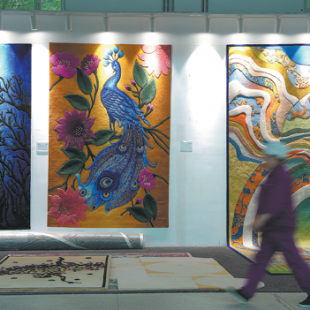Weaving the past into the vibrant future of Tibetan carpets


XINING — In a brightly lit workshop in Xining, capital of Northwest China's Qinghai province, the rhythmic snip of scissors and the hum of looms blend into a steady melody. Among the workers, 56-year-old Yang Yongliang moves easily between looms and trainees, his hands tracing patterns passed down through generations.
A veteran practitioner of the millennium-old Jiaya Tibetan carpet-weaving craft, Yang has recently taken on a new role as a technical consultant for a local carpet factory, while continuing his lifelong mission to preserve the ancient art form.
"The more people learn this craft, the better chance we have of keeping our ethnic culture alive and preserving this ancient skill for future generations," Yang said from a factory workshop of the Shengyuan Carpet Group, one of the largest Tibetan carpet producers in China, located in Xining, the provincial capital.
With a history of more than 2,000 years, Tibetan carpet is a traditional handicraft on the Qinghai-Tibet Plateau. In 2006, the Jiaya Tibetan carpet-weaving skills were inscribed in China's first group of national intangible cultural heritage items.
According to Yang, Jiaya Tibetan carpets are known for their deep hues, and are made from natural wool and high-quality yak hair that are produced locally in Qinghai. The carpets are not only durable but also environmentally friendly, he adds.
Once a household necessity for warmth, Tibetan carpets are finding new life in today's markets. Government support and enterprise participation have helped blend traditional craftsmanship with contemporary design.
In a Shengyuan workshop, employees skillfully trim the machine-woven patterns, bringing once-flat designs to life. "Machines handle the basic weaving to improve efficiency, while skilled artisans finish the rest by hand, adding unique character to each carpet," says Che Guolong, who heads the company's design and research department.
The design team also studies traditional Tibetan carpet patterns and, with the aid of artificial intelligence, has built a database of tens of thousands of designs. By integrating modern design elements, they have created carpets with three-dimensional patterns, sparkling motifs and other innovative features.
With improved quality and innovative designs, the factory's Tibetan carpets have found markets across China and more than 40 other countries and regions, including Italy, Japan and the United States. In the first half of this year, its export revenue increased by more than 8 percent, with annual exports remaining steady at above 80 million yuan ($11.3 million).
"Besides passing down the handcrafting skills, for us, inheritance also means carrying forward the spirit and culture behind them," says Xue Ting, the company's chairperson. Xue believes that only by combining innovation with tradition can the Tibetan carpet industry continue to thrive.
From cultural heritage workshops to smart factories, and from safeguarding tradition to embracing innovation, Tibetan carpet products have expanded from a handful of original varieties to about 28 series and over 100 different types. Local authorities have introduced policies to promote industrial upgrading and high-quality development, while cultivating a skilled group of workers to sustain growth.
In recent years, Yang has also held classes in Xining and its surrounding areas, teaching more than 200 students the art of Tibetan carpet weaving.
"I have been in this craft for 40 years. I once thought of myself simply as an artisan," Yang says. "But now, with the government placing greater emphasis on Tibetan carpets, I am determined to find every possible way to preserve and promote this traditional skill."





































